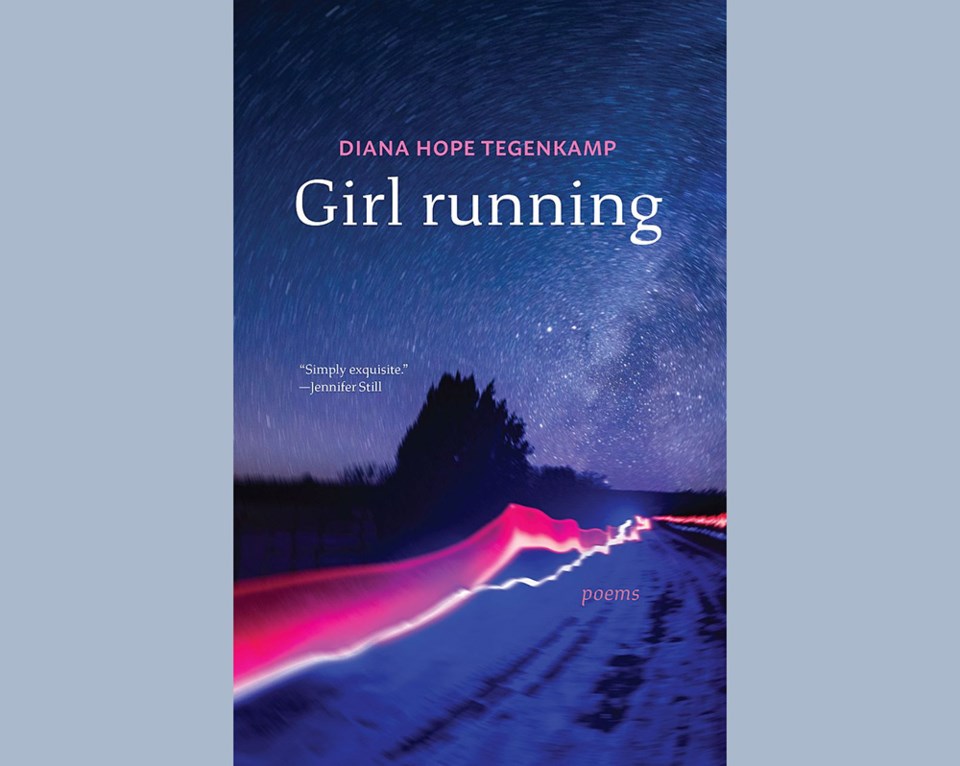Girl running
By Diana Hope Tegenkamp
Published by Thistledown Press
$24.95 ISBN 978-1-77187-214-0
When a veteran multi-disciplinary artist pens a poetry collection, it’s likely that the influence of her other art practices will seep into the pages and make for an original read. This is evidenced in the case of Diana Hope Tegenkamp, a Saskatoon-based poet who also works with film, photography, visual and performance art, sound and music. In her debut poetry book, Girl running, Tegenkamp’s 23-page poem incorporates various fonts, strike-outs, quotations, footnotes and superimposed text across a “mountain-like shape” which is “an outline of the iceberg that sunk the Titanic,” and the entire long poem is a conversational response to an 1809 textbook (Letters on Ancient History, by Anne Wilson). It is intriguing, and so are the questions it poses about history and subjectivity. “History, a whirlpool, 32/sucking in obscure circumstances/with a frightful noise.33”
Tegenkamp also alludes to sculpture, novels, paintings and films. For example, director Jane Campion’s adaptation of “Portrait of a Lady,” and there’s a poetic close-up of a poignant scene from “Boys Don’t Cry,” the 1999 Academy Award-winning movie concerning the tragic, real-life story about murdered trans man Brandon Teena in Nebraska.
The poems in this book appear in various shapes and forms, from couplets and tercets to the three, page-long “Loop” poems, which are dreamy, yummy, stream-of-consciousness prose poems inspired by Canadian poet Nicole Brossard’s work. Lines from Tegenkamp’s first “Loop” demonstrate her keen ear and eye, with special attention paid to the wind, colour, ordinary domestic scenes, the natural world and philosophic leaps: “The rise and fall of piano notes, computer’s hum, and backroads where the wind blows clean through. Pattern of pink blossoms on my living room chair and the animal nature of letters, forming, begetting, coupling tactile experience and supple thinking.”
As a prairie poet, light, wind and winter feature greatly. As a visual artist, these poems are deliberately seeped in colour, from a father’s “green Pontiac” to “white zinnias” and “cormorants/blue ghosts on the telephone wire.” I love the space this artist allows around several lines in her poems. This affords readers time to contemplate lyrical lines like this: “What about so much light/the mind goes white?”
These poems often examine seeing and being seen. The tender first poem ends with “the ongoingness of I see you”. From “Clouds”: “Touch the tree trunks and tell the clouds:/I see you.” The writer observes “dark pines rise from the mollusk dawn” (“The Return”), and she includes a sublime description of winter and a beloved mother’s failing vision: through “her left eye,/morning seen through/snow granules.” (“Little Winters”). These are also poems about metaphorical vision, “the feast of geranium petals, red swoon/across the lawn”.
Tegenkamp’s debut book is luminous, partly because she juxtaposes the everyday — Mom pours coffee, puts cream and sugar/on the counter. Wipes the wink with a towel” — with insightful assertions — “Time, she says, does not flow in even measures,” but mostly because Tegenkamp’s just a damn fine writer.
Several of the poems salute her mother (d. 2018), but these chiseled poems should resonate with anyone.
This book is available at your local bookstore or from the Saskatchewan Publishers Group www.skbooks.com

.JPG;w=120;h=80;mode=crop)
.JPG;w=120;h=80;mode=crop)

